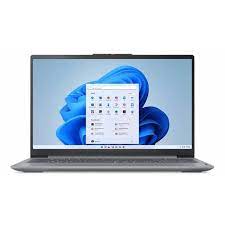The Lenovo IdeaPad 1i is an entry-level Windows laptop designed for basic productivity, web browsing, and media consumption. With a 15.6-inch Full HD touchscreen, lightweight design, and affordable price, it targets students, casual users, and those needing a secondary laptop.
This review examines its hardware, performance, display, battery life, and overall usability to determine if it’s worth buying.
Full Hardware & Software Specifications
Processor & Performance
- CPU: Intel Pentium Silver N5030 (Gemini Lake Refresh, Quad-Core, 1.1GHz base, up to 3.1GHz boost)
- GPU: Intel UHD Graphics 605 (integrated)
- RAM: 4GB LPDDR4 (soldered, non-upgradable)
- Storage: 128GB eMMC (non-upgradable, no SSD slot)
Display
- Size: 15.6-inch
- Resolution: 1920 x 1080 (Full HD)
- Panel Type: IPS LCD
- Touchscreen: Yes (10-point multi-touch)
- Brightness: ~220 nits (typical)
- Anti-glare coating: No (reflective screen)
Design & Build
- Material: Plastic chassis
- Weight: 1.6 kg (3.53 lbs)
- Thickness: 19.9 mm (0.78 inches)
- Color: Abyss Blue
- Keyboard: Non-backlit, standard chiclet keys
- Touchpad: Plastic, Windows Precision drivers
Connectivity & Ports
- Wi-Fi: 802.11ac (2.4GHz & 5GHz)
- Bluetooth: 4.2
- Ports:
- 1x USB 3.2 Gen 1 (Type-A)
- 2x USB 2.0 (Type-A)
- 1x HDMI 1.4b
- 1x 3.5mm headphone/mic combo jack
- 1x MicroSD card reader
- No USB-C, no Ethernet port
Battery & Power
- Battery: 35Wh (non-removable)
- Adapter: 45W barrel-type charger
- Battery Life: ~6-7 hours (light usage)
Audio & Webcam
- Speakers: 2x 1.5W stereo (down-firing, weak bass)
- Microphone: Dual-array (average for calls)
- Webcam: 720p (no privacy shutter)
Operating System & Software
- OS: Windows 11 Home in S Mode (can switch to full Windows 11)
- Pre-installed Software:
- Lenovo Vantage (system management)
- McAfee LiveSafe (trial)
- Microsoft 365 (trial)
- Various bloatware (can be uninstalled)
Performance & Real-World Usage
General Productivity
- Web Browsing: Handles 5-10 Chrome tabs smoothly.
- Office Apps: Runs Word, Excel, and PowerPoint well.
- Multitasking: Struggles with multiple apps due to 4GB RAM.
Media Consumption
- Streaming: 1080p YouTube/Netflix works fine.
- Touchscreen: Responsive but not essential for most users.
Gaming & Creative Work
- Casual Games: Runs Minecraft (low settings) and browser games.
- Photo Editing: Basic Photoshop use is slow.
- Video Editing: Not recommended (struggles with 1080p rendering).
Display & Touchscreen Experience
- Pros:
- Full HD resolution is sharp for a budget laptop.
- IPS panel provides decent viewing angles.
- Touchscreen is useful for Windows gestures.
- Cons:
- Low brightness (~220 nits) makes outdoor use difficult.
- Reflective screen causes glare under bright lights.
Battery Life & Charging
- Light Use (web browsing, documents): ~6-7 hours
- Video Playback (local files): ~5-6 hours
- Heavy Use (multiple apps): ~3-4 hours
- Charging: Takes ~2 hours for a full charge.
Pros & Cons
Pros
- Affordable price for a Full HD touchscreen laptop.
- Lightweight and portable.
- Decent display for media consumption.
- Windows 11 (can exit S Mode for full app support).
Cons
- Weak processor (Pentium N5030 is slow for multitasking).
- 4GB RAM is insufficient for modern Windows 11.
- 128GB eMMC storage is slow and non-upgradable.
- No USB-C or backlit keyboard.
- Below-average speakers.
Final Verdict
Who Should Buy It?
- Students needing a basic laptop for notes and web browsing.
- Casual users who only check emails and watch videos.
- Those who want a touchscreen at a low price.
Who Should Avoid It?
- Power users needing multitasking or heavy apps.
- Gamers or creative professionals.
- Anyone needing future-proof storage/RAM.
Alternatives to Consider
- Acer Aspire 3 (Ryzen 3, better performance).
- HP 15-dw3000 (FHD, more RAM/storage options).
Rating: 6/10
A budget-friendly but limited laptop—good for basics but held back by slow storage, low RAM, and weak CPU. Only recommended if the touchscreen is a must-have feature.
